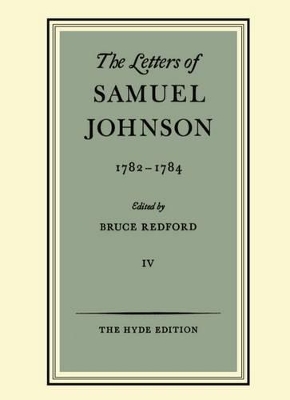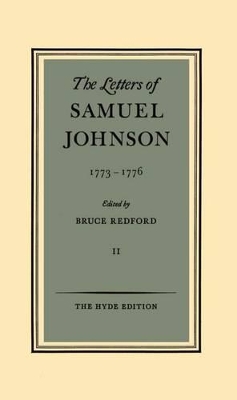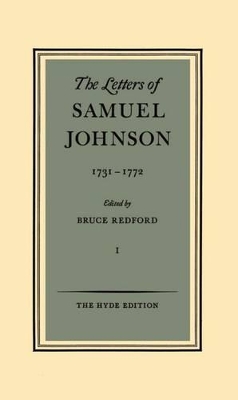Letters of Samuel Johnson
4 total works
The Letters of Samuel Johnson, known as the Hyde Edition, is the most complete scholarly edition of Johnsons's letters ever to appear. In editing these five volumes, Bruce Redford has included fifty-two newly discovered letters or parts of letters, and he has supplied more accurate versions of many others. Redford also has decoded numerous references that previously had resisted explanation, and his annotations integrate the vital discoveries of recent
scholarship. The overall result is a far richer understanding of Samuel Johnson's life, work, and milieu.
The Hyde Edition offers major professional advances over all previous publication of these materials. It transcribes scores of texts from the original documents for the first time - a feature of special importance in the case of Johnson's revealing letters to Hester Thrale, a number of which have been available only in expurgated form. It is the first edition systematically to record substantive deletions in a way that will allow readers a more intimate knowledge of stylistic procedures,
mental habits, and chains of association. The Hyde Edition also documents the current disposition of the manuscripts, hundreds of which have changed hands in recent decades.
Volume IV chronicles the last three years of Johnson's life, a period of protracted struggle against a variety of ailments and of heroic commitment to preserving a sound mind in a radically unsound body. This epistolary endgame includes the breakup of the friendship with Hester Thrale, medical dramas of every description, and a poignant reaching out to new friends and new experiences. The letters of 1782-84 exemplify in abundance what Johnson himself praises and provides, 'the interchange
of that social officiousness by which we are habitually endeared to one another."
scholarship. The overall result is a far richer understanding of Samuel Johnson's life, work, and milieu.
The Hyde Edition offers major professional advances over all previous publication of these materials. It transcribes scores of texts from the original documents for the first time - a feature of special importance in the case of Johnson's revealing letters to Hester Thrale, a number of which have been available only in expurgated form. It is the first edition systematically to record substantive deletions in a way that will allow readers a more intimate knowledge of stylistic procedures,
mental habits, and chains of association. The Hyde Edition also documents the current disposition of the manuscripts, hundreds of which have changed hands in recent decades.
Volume IV chronicles the last three years of Johnson's life, a period of protracted struggle against a variety of ailments and of heroic commitment to preserving a sound mind in a radically unsound body. This epistolary endgame includes the breakup of the friendship with Hester Thrale, medical dramas of every description, and a poignant reaching out to new friends and new experiences. The letters of 1782-84 exemplify in abundance what Johnson himself praises and provides, 'the interchange
of that social officiousness by which we are habitually endeared to one another."
"The Letters of Samuel Johnson" contains 52 previously unknown letters or parts of letters which have come to light since R.W. Chapman's work on the subject, published in 1952. For the first time, substantive deletions are recorded, yielding intimate knowledge of Johnson's stylistic procedures, mental habits and chains of association. Furthermore, detailed ownership credits document the current disposition of the manuscripts, hundreds of which have changed hands during the last four decades. Finally, the annotation of the letters incorporates the many significant discoveries of post-war Johnsonian scholarship, as well as decoding references that had resisted explanation before.
"The Letters of Samuel Johnson" contains 52 previously unknown letters or parts of letters which have come to light since R.W. Chapman's work on the subject, published in 1952. For the first time, substantive deletions are recorded, yielding intimate knowledge of Johnson's stylistic procedures, mental habits and chains of association. Furthermore, detailed ownership credits document the current disposition of the manuscripts, hundreds of which have changed hands during the last four decades. Finally, the annotation of the letters incorporates the many significant discoveries of post-war Johnsonian scholarship, as well as decoding references that had resisted explanation before.
This is the first scholarly edition of Johnson's letters to appear for forty years. It presents new letters, more accurate texts, and more up-to-date annotation than its predecessors. Fifty-two previously unknown letters or parts of letters have come to light since R. W. Chapman's edition (Oxford, 1952). Such `new' letters, however, are scarcely more important than those for which only inferior printed texts or copies of varying reliability have previously been available. This edition offers scores of texts transcribed for the first time from the original documents - a statistic of special importance in the case of Johnson's revealing letters to Hester Thrale, many of which have only been known in expurgated form.
For the first time, substantive deletions are recorded, yielding intimate knowledge of Johnson's stylistic procedures, mental habits, and chains of association. Furthermore, detailed ownership credits document the current disposition of the manuscripts, hundreds of which have changed hands during the last four decades. Finally, the annotation of the letters incorporates the many significant discoveries of post-war Johnsonian scholarship, as well as decoding references that had resisted explanation before. The result is a more accurate and more comprehensive understanding of Samuel Johnson, man of letters.
For the first time, substantive deletions are recorded, yielding intimate knowledge of Johnson's stylistic procedures, mental habits, and chains of association. Furthermore, detailed ownership credits document the current disposition of the manuscripts, hundreds of which have changed hands during the last four decades. Finally, the annotation of the letters incorporates the many significant discoveries of post-war Johnsonian scholarship, as well as decoding references that had resisted explanation before. The result is a more accurate and more comprehensive understanding of Samuel Johnson, man of letters.



